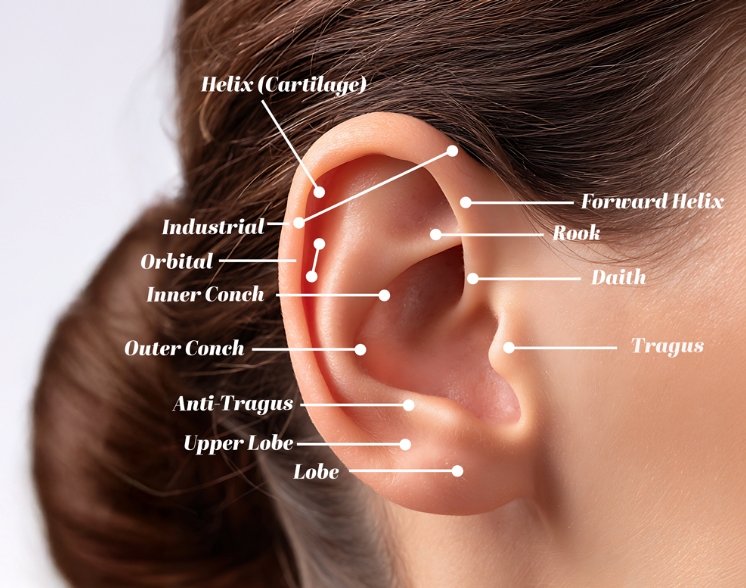Cartilage piercings are one of the most versatile ear modifications, ranging from the helix to the conch, tragus, rook, and industrial. This article explains what cartilage piercings are, the types of jewelry used, placement variations, aftercare routines, and safety precautions. You should read this article because it gives clear definitions, precise healing guidelines, and expert information on risks and jewelry sizing that help ensure safe and professional results.
What is a Cartilage Piercing?
A cartilage piercing is a body modification that penetrates the connective tissue of the ear, which is firmer than skin but more flexible than bone. The most common cartilage piercing is the helix, located at the upper rim of the ear, but professional piercers also perform placements such as the snug, conch, orbital, daith, tragus, anti-helix, rook, and forward helix.

During the procedure, a piercer selects sterile jewelry, marks the chosen site, and pierces the tissue using a hollow needle. The jewelry is inserted immediately. The full setup, sterilization, and piercing process typically takes only a few minutes.
What Jewelry is Used for Cartilage Piercings?
Cartilage tissue swells significantly after piercing, so professional piercers use larger starter jewelry. Standard sizes range from 18G, 16G, to 14G, with lengths of 5/16 inch or more to accommodate swelling.
-
Initial jewelry: captive bead rings or barbells, which are easy to clean and reduce infection risk.
-
Healing phase: 2–3 months before resizing to a snugger fit.
-
Long-term options: decorative barbells, clusters, and custom rings for aesthetic projects.
Professional piercers avoid complex jewelry with multiple crevices during healing since it can trap bacteria.
Types of Cartilage Piercings
Outer and Inner Conch

The conch piercing targets the thickest cartilage of the ear, making it ideal for bold jewelry and stable placements. This section explains the difference between outer and inner conch piercings, jewelry choices, and cost considerations.
-
Outer conch pierces the flat middle-lower ear shell.
-
Inner conch pierces the upper ear shell, closer to the canal.
Jewelry: barbells, flatbacks, or push-pin posts.
Cost: $30–50 for standard pieces, $80+ for ornate options.
Note: cartilage does not stretch like earlobes; large-gauge piercings must be done at the intended size.
Tragus
The tragus piercing highlights the small flap covering the ear canal. Its location makes the process slightly more advanced than a standard helix.
-
Location: small flap in front of the ear canal.
-
Gauge: usually 16G.
Jewelry: flatback barbell or threadless post; rings after healing.
Cost: $40–60 depending on jewelry style.

Antitragus
The antitragus piercing requires a prominent ridge between tragus and earlobe. Not everyone has suitable anatomy, which makes professional evaluation essential.
-
Location: ridge between tragus and earlobe.
-
Gauge: 16G with curved or flat barbell.
-
Jewelry upgrade: captive ring after healing.
Cost: $40–60.
Helix

Helix piercings are the most common and widely recognized cartilage piercing. They decorate the upper rim of the ear with rings or barbells.
-
Location: upper ear rim.
-
Gauge: 18G–14G.
-
Jewelry: ring, barbell, or circular barbell.
Cost: $30–50.
Forward Helix
Forward helix piercings sit at the front ridge above the tragus. They are often styled in doubles or triples for symmetry.
-
Location: upper front ridge above tragus.
-
Often placed in double or triple vertical rows.
-
Jewelry: flatback barbells or push-pin posts.
Cost: $30–60 per piercing.
Industrial

The industrial piercing links two points of cartilage with a single barbell. This gives the ear an edgier, structural look compared to single piercings.
-
Combination of two piercings (outer + forward helix) connected by a straight barbell.
-
Gauge: 14G.
Jewelry: straight industrial barbell with optional decorative ends.
Cost: $60–100.
Complete your industrial piercing with Pierced Addiction’s premium barbells. Explore Industrial barbells with bold decorative ends, crafted for style and durability.
Orbital

An orbital piercing connects two holes with one ring. The result is a design where the jewelry appears to orbit the ear.
-
A ring connecting two piercings (common in helix, rook, or conch).
-
Gauge: 16G–14G.
Cost: $50–80.
Rook

The rook piercing passes vertically through the fold above the tragus. It is well suited for curved barbells that sit neatly inside the ridge.
-
Vertical piercing through cartilage fold above the tragus.
-
Gauge: 16G with a curved barbell.
Cost: $30–50.
Snug

The snug piercing is one of the tightest placements on ear cartilage. It runs horizontally through the inner ridge above the antitragus.
- Horizontal piercing along the inner ridge above antitragus.
-
Gauge: 16G with curved barbell.
Cost: $30–50.
Daith

The daith piercing is positioned in the innermost fold above the canal. Its distinctive location allows for decorative rings that accentuate the ear’s center.
-
Piercing through the fold above the canal, inside the conch.
-
Gauge: 16G with a ring or clicker.
-
Jewelry: often decorative rings (hearts, moons, stars).
Cost: $30–60.
Note: Anecdotal reports suggest daith piercings may stimulate migraine-related pressure points, but evidence is limited.
Aftercare for Cartilage Piercings
Cartilage piercings require a healing period of 4 months to 1 year, depending on placement and gauge size. During this time, jewelry must remain in place because removing it too early increases the risk of closure. Cleaning is best done twice daily using a sterile saline solution.
Cleaning protocol:
-
Mix 4 teaspoons of non-iodized sea salt with 1 gallon of distilled water.
-
Warm a small portion of the solution to body temperature.
-
Soak the ear in a glass or porcelain cup for 7–15 minutes, twice daily.
-
Pat dry with a clean towel.
Do not remove jewelry during healing. If removed, the piercing can close rapidly.
Common Risks and Precautions
Cartilage piercings are more prone to problems than soft-tissue piercings because of the density of the tissue. The most frequent issues include infection from touching the piercing, sleeping on it, or exposing it to water in pools, lakes, or hot tubs.
Hypertrophic scarring or keloids may also occur due to trauma or poor aftercare, while migration or rejection can happen if the anatomy or jewelry is not suitable. To minimize risk, avoid unnecessary contact with the piercing and select jewelry professionally fitted for your ear.
Above all, cartilage piercings must always be performed with a sterile hollow needle. Piercing guns should never be used, as they can shatter cartilage and cannot be sterilized to professional standards.

